229 Search Results for partner strategies
May 9, 2016
by Carole Zangari -
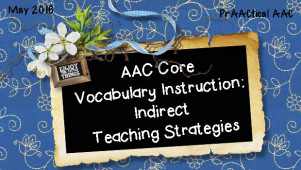
It has been so exciting to see that AAC learners are increasingly provided with communication boards, books, SGDs, and apps that feature a robust set of core vocabulary words. For many years, ‘providing AAC’ used to mean access to topic and choice boards or activity-specific communication displays (ABCDs). Now, we recognize the limitations of those approaches and do our best to move beyond them in favor of more linguistically robust options. AAC systems with core vocabulary that is organized to support the development of a motor plan allows learners to build and grow their skills over time. For a long time, the AAC field has known that providing access to appropriate tools (in this case, a core vocabulary set) is only the first step toward successful use of augmentative communication. Providing it is necessary but not sufficient for most AAC learners to develop any sort of linguistic competence. For... [Read More...]
April 29, 2016
by Carole Zangari -
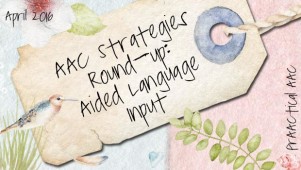
We’ve been writing about aided language input, a pivotal strategy for supporting AAC learners, for several years. In fact, there are over 200 posts tagged with this term. In this post, we gather together some of the most popular posts on this fundamental intervention strategy. Implementation A PrAACtical Idea for Aided Language Input Using Aided Language Input to Build Communication Opportunities! How I Do It: Implementing Aided Language Input with Alicia Garcia Pivotal Skills for AAC Intervention: Aided Language Input How We Do It: Controlled Practice in Partner Augmented Input with Jill Senner & Matthew Baud Text-Based Aided Language: Making the Literacy-Communication Connection for Children with Autism Videos PrAACtical Resources: Video Explainers for Aided Language Input Video of the Week: Aided Language Input with Gail Van Tatenhove Video of the Week: Aided Language Input with Dr. Caroline Musselwhite PrAACtical Resources: Video Examples of Aided Language Input Aided Language Input in... [Read More...]
April 18, 2016
by Carole Zangari -
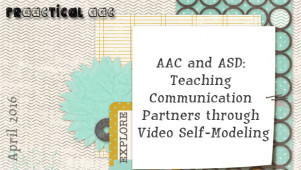
It is an honor to have Dr. Joanne Cafiero, an AAC consultant for individuals with complex communication needs and Autism Spectrum Disorders, as a guest contributor for today’s post. Dr. Cafiero is the author of Meaningful Exchanges for People with Autism an Introduction to AAC (2005). She is a consulting editor for Focus on Autism and Other Developmental Disabilities and has guest edited several of ASHA’s Perspectives in AAC. She was a member of the National Academy of Sciences Committee on Educational Interventions for Children with Autism (2001) and is currently working on an update on AAC and Autism for the Academy. In this post, she shares some of her work on video self-modeling. ::::::::::::::::::::::::::::::::::::::::::::::::: Growing research and first-person reports are illuminating the unique sensory and motor differences experienced by people on the Autism Spectrum. This new information has a huge impact on the AAC practitioner. Motor planning differences in ASD can... [Read More...]
April 14, 2016
by Carole Zangari -
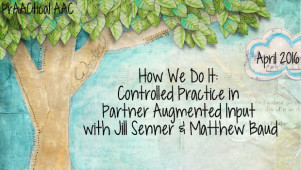
Today, we welcome back Dr. Jill Senner and Matthew Baud to talk about some of their strategies for implementing AAC. They have some great ideas for helping partners better support AAC learners. You can read some of their previous posts here. In the meantime, let’s see how they are helping communication partners develop their AAC facilitation skills. :::::::::::::::::::::::::::::::::::::::::::::::::::::::::::: Most of us already know that evidence-based research supports the use of partner-augmented input (PAI) as an intervention strategy for individuals who use AAC. However, simply having awareness of a strategy does not mean that one can easily use it. To quote Jim Knight, “We wouldn’t teach someone to drive by giving them a lecture, tossing them a book, and then turning them loose on the freeway.” Indeed, in order to learn a new skill, communication partners often need practice. In fact, one may need to try a new strategy or skill... [Read More...]
June 10, 2015
by Carole Zangari -
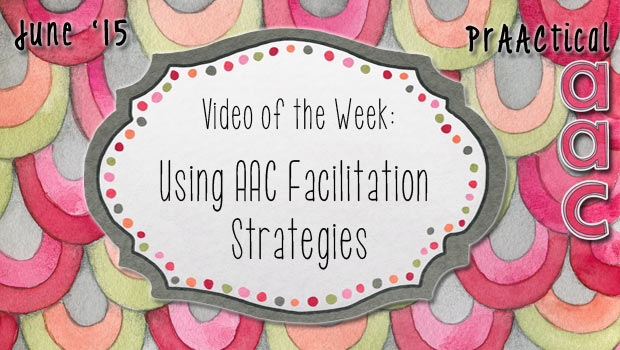
How can adults and peers who serve as communication partners support AAC learners in their interactions? Dr. Rae Sonnenmier of the Institute on Disability at the University of New Hampshire has lots of implementation ideas.
December 23, 2014
by Carole Zangari -
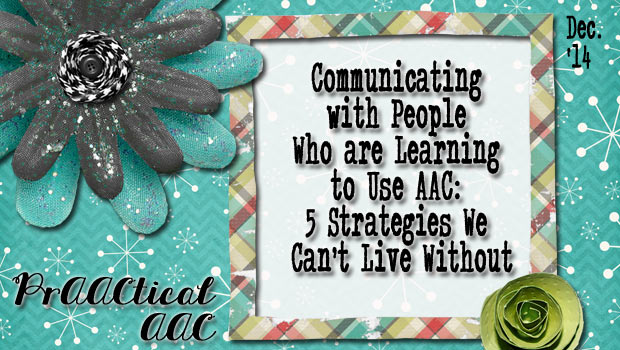
Don’t pre-empt: Give them a chance to express themselves by not automatically anticipating and meeting every need they have. What can make us nurturing caregivers sometimes gets in the way of building new communication skills. Create opportunities: Engineer those ‘teachable moments’ by using communication temptations. Making them want to communicate is half the battle. Slow down and pause: Nature abhors a vacuum. And we SLPs have a terrible time NOT talking. That’s a shame, really, because those ‘perfect pauses’ are wonderful teaching tools. Speak AAC: We can’t say this often enough. To teach someone to communicate with AAC symbols, we must speak to the learners using those same tools. When we want someone to use their communication aid more often, we make it a priority for US to use the AAC more frequently. That’s just how it works for beginning communicators. Prompt wisely: A little prompting is a good and... [Read More...]
August 17, 2013
by Carole Zangari -
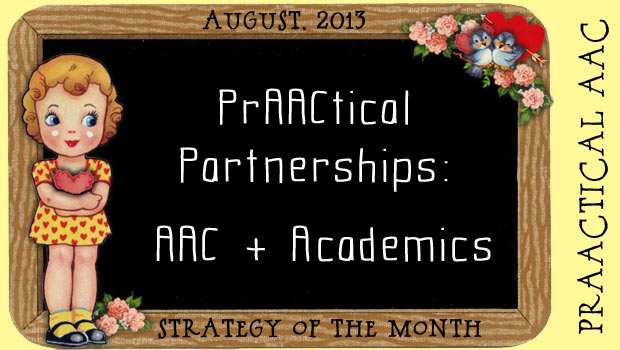
Like many of you, we are always racking our brains trying to help students who use AAC be successful academically. Because we serve these students in a clinical setting, we could easily pass on the opportunity to align our AAC goals with academic standards but what would be the fun in that? Here are some things we try to think about with school-aged kids who have AAC needs. SLP to SLP If it takes a village to raise a child, how many people does it take to help a kids with AAC needs to develop communicative competence and succeed academically? It boggles the mind. As SLPs, message is this: We have to work together. Many kids who use AAC have private therapies in addition to their school services, and yet, we rarely connect. We have to find a way to do a better job at this so that kids with... [Read More...]
June 29, 2013
by Carole Zangari -
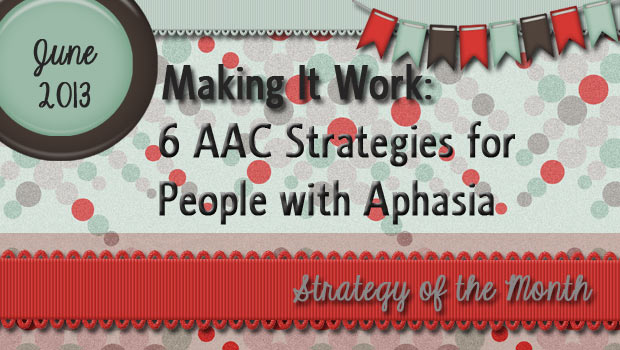
People with aphasia are often most successful when a number of different strategies are combined. In this post, we discuss a number of strategies that we can use in our therapy and teach to communication partners. Augmented Input We’ve written so many posts about aided language input that we’re almost embarrassed to bring it up again. Almost. It seems like no matter which age group or clinical population is the subject of our post, that strategy plays a central role. It is the same for people with aphasia with one exception. They benefit from a broader array of input cues, such as gestures, writing, and even pantomime. Augmented input is the term that is used to refer to oral language that is supplemented with pictures, print, gestures, pantomime, and the use of objects in the environment. By using these things as you speak, you enhance the ability of the person... [Read More...]
June 15, 2013
by Carole Zangari -
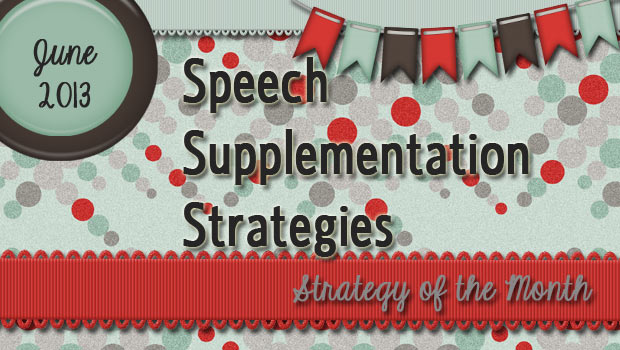
Anyone who has had a conversation with someone affected by aphasia is probably familiar with the ‘20 Questions’ approach to resolving communication breakdowns. Asking questions helps us take the piece of the message we understand (or think we do!) and build on that to gain more insight into the communicator’s intent. Take this exchange between a woman, Sandy, and her mother-in-law, Joan. Joan had a stroke a few years back and has both aphasia and dysarthria. Joan: “Gay” Sandy: “Gay? What do you mean, mom? Someone’s gay?” Joan: Shake head. “Gay” Sandy: “I’m not sure, mom. Gay?” Joan: “Gay” Points to the front door Sandy: “Kay? Are you telling me about Kay from across the street?” Joan: “Gay.” Nods Sandy: “What about Kay? Did she call?” Joan: Shakes head no Sandy: “Do I need to call her?” Joan: Shakes head no Sandy: “Did she stop by?” Joan: “Aaadihdih” Sandy: “Did... [Read More...]
August 12, 2012
by Carole Zangari -
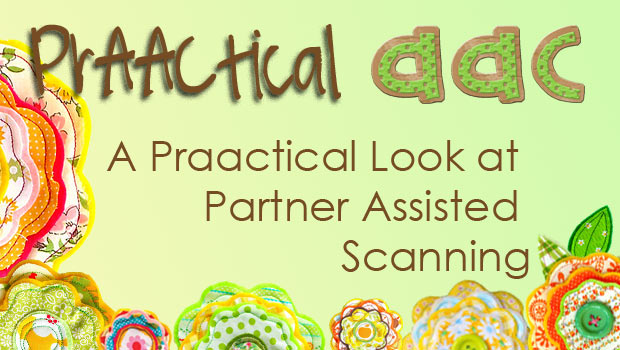
Awhile back, we listed a few strategies that seem to be under-utilized in AAC. One of those is partner assisted scanning, a strategy we love for its boundless flexibility. In this week’s video we turn to the Cincinnati Children’s Hospital Medical Center’s Aaron W. Perlman Center. Tune in for a clear description of the strategy and lots of wonderful examples. You can learn more from them here. – –









